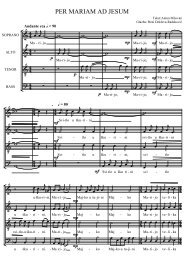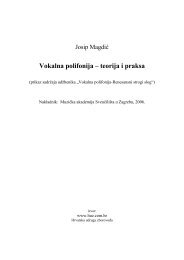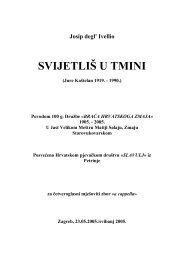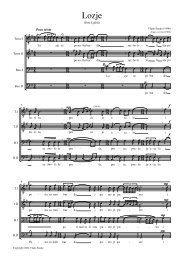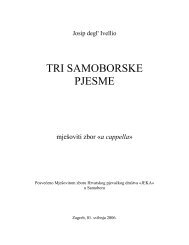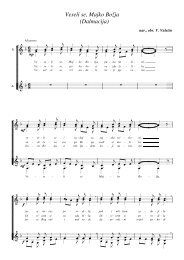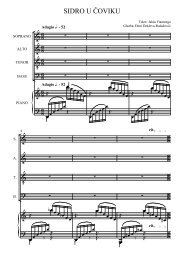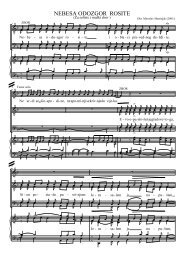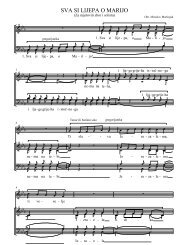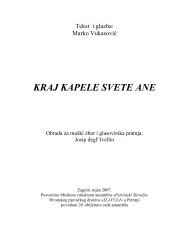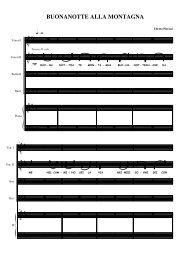ARS CHORALIS 2010 - Hrvatska udruga zborovođa
ARS CHORALIS 2010 - Hrvatska udruga zborovođa
ARS CHORALIS 2010 - Hrvatska udruga zborovođa
Create successful ePaper yourself
Turn your PDF publications into a flip-book with our unique Google optimized e-Paper software.
has several aspects: emotional, lifestyle related, medical, pedagogical. Since those aspects are<br />
often related to each other, a multi-dimensional approach for treating the patient is required. In<br />
this presentation, several boundary conditions for a “good” voice are established. To illustrate the<br />
effects of medical and pedagogical measures, we show case studies from our regular work with<br />
voice patients.<br />
• Vocal Folds Adduction and Registers in Classical Singing (L) (E)<br />
Register control in singing is physiologically achieved mostly by the vocalis muscle (membranous<br />
adduction). On the other hand, the degree of adduction of the posterior part of the glottis (cartilaginous<br />
adduction, regulated by laryngeal adductory muscles PCA and IA) is known to have an<br />
influence on the “richness” of the vocal sound source. In a recent study it has been shown, that<br />
both trained and untrained singers can independently vary those two types of laryngeal adjustment.<br />
The independent control over cartilaginous and membranous adduction allows singers to create<br />
different vocal timbres at the laryngeal level. In singing pedagogy, this knowledge can be used to effectively<br />
address certain technical problems, such as running out of breath, or register violations.<br />
• Voice Timbre in Singing (L) (E)<br />
Timbre, known in psychoacoustics as tone quality or tone color, distinguishes different types of<br />
sound production. In singing, timbre is influenced by vowel quality, amount of high-frequency<br />
energy components (“overtones”, singers’ formant) and the noise level (degree of breathiness).<br />
Those sound qualities are mainly controlled by two physiologic means: adjustments of the vocal<br />
tract and adjustments of the sound source, i.e. the laryngeal configuration.<br />
Joy Hill (United Kingdom) • British conductor Joy Hill directs<br />
the Royal College of Music Junior Department Chamber<br />
Choir, Girls’ Choir and the alumni RCMJD Chamber Choir<br />
Vigala Singers. She currently teaches academic music at the<br />
Purcell School where she conducts the Purcell Chamber Choir,<br />
and is known for her commitment to ‘giving new music a<br />
chance’, actively promoting performances of music by young<br />
student composers as well as high profile contemporary composers.<br />
Originally a first-study pianist studying with Eric Parkin and Christopher<br />
Elton Joy won the Vancouver Chamber Choir scholarship to study conducting with<br />
Jon Washburn in Canada and was awarded a Churchill Fellowship for the study<br />
of choral conducting in Sweden. She has worked as conductor and adjudicator in<br />
Australia, Japan, Canada, Estonia, Latvia, Lithuania (sponsored by the Arts Council<br />
of Great Britain), Italy, South Africa and Uganda. Formerly Senior Lecturer in<br />
Music and Music Education, University of Surrey Roehampton and the Institute<br />
of Education, London University, she is increasingly involved in projects that bring<br />
The First International Artistic and Scientific Symposium on Choral Art, Singing and Voice – Zagreb, Croatia<br />
19



